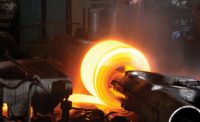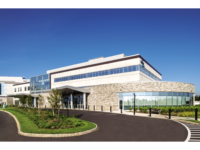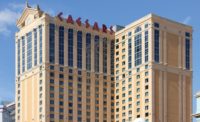A 1965 cast-in-place concrete office building in Bala Cynwyd, Pa., was showing its age. The tenants were hot in the summer and cold in the winter, and the 345,000 square-foot building needed an update inside and out to address occupant comfort and energy efficiency. Renovation to an existing concrete structure is a challenge, even more-so while it is fully occupied. Tishman Speyer, the building owners, called in McGillin Architecture Inc. for the project.
The original plan was to replace the original single-glazed ribbon windows, build a small entrance addition, and refresh the exterior with new paint. Replacing the windows seemed like a relatively simple task, but early investigations found that the cast-in-place concrete on the upper four stories was not suitable to support modern window systems. The team quickly determined that a new design approach was needed.
A Cost-Effective Choice
Architect David C. Cremer with McGillin Architecture Inc., knew that speed and minimal disruption of the building tenants were of primary importance, so he consulted with Sto Corp. and its affiliate, Jersey Panel. After much discussion, 25,000 square feet of StoPanel Classic NExT ci was specified for the project. This lightweight prefabricated insulated panel is energy efficient and durable, with continuous insulation and StoGuard waterproof air barrier. The panel adds vertically notched adhesive, drainage wedges and weeps. At 8 to 10 pounds per square feet, this was a logical, energy-efficient and cost-effective choice.
“[The] panel system was the least expensive choice with the highest level of quality control and made much more sense than field applied EIFS for this project,” says Cremer. “The ability to have a drainable system was very important, too. Sto was receptive and willing to work with us every step of the way.”
According to Cremer, the first two stories were in better shape and the existing cast-in-place concrete was repaired before they replaced the old storefront windows with a new thermally broken system. For stories three through six, however, that approach was not feasible. The team determined that the best approach would be to build an entirely new exterior skin right outside the existing facade, increasing the footprint of the structure by 9 inches. Approximately 11,000 linear feet of steel angles were bolted along the entire perimeter of the building at the head and sill of each existing ribbon window. Precision was paramount, as these angles needed to support the prefabricated panel system and the unitized ribbon window system without interfering with any of the required attachment and hoist points. The system, acting as a new primary skin along with the new double-glazed ribbon windows, was then mounted between the steel angles at each floor level. The precision craftsmanship and quality control that StoPanel and its experienced engineers were able to provide made a difference.
“The panels were fully customized, as we wanted to minimize the amount of sealant joints required,” says Cremer. “Sto was able to provide a larger panel compared to its competitors which means less maintenance of the joints for the building operators, so they provided a great system for this project. Each panel is constructed from 4-inch 18-gauge metal studs, packed with mineral wool insulation, DensGlass and 21/2 inches of StoPanel Classic NExT ci. It was very important to increase the thermal performance of the building for the tenants’ comfort, who were continuing to work in the building during the entire construction process.”
Panelization
The time savings with panelization was instrumental in reducing disruption to the tenants. The panels were fabricated off-site at Jersey Panel and so the panel installation took only a short three months, which meant the cranes were only around the building for a short time as well. But even that came with its own challenges: The tenant entrances needed to remain open during normal business hours. As a result, the installation of the panels was performed during third shift and Saturdays, according to John Schad in Operations with Jersey Panel.
In addition, the construction of steel angles that supported the panels took longer than planned. In a field applied situation, this would mean potentially lengthy project schedule delays. Fortunately, Jersey Panel could continue manufacturing the panels and storing them at their facility while that portion of the construction process was being completed, minimizing the potential delay.
“With field applied EIFS, external conditions can change and we couldn’t afford to lose that much time,” says Cremer. “The panels alleviated that issue, and had some additional advantages over field applied, including a cleaner jobsite.” With the panel system assembly being performed off site, it reduced the paint overspray, and created overall cleaner air on the job site.
The Lotus Leaf
The unique StoPanel retrofit not only provides significant cost savings with the new energy efficient cladding system, it also looks stunning with Stolit Lotusan 1.0, a ready-mixed exterior textured finish that mimics the self-cleaning capabilities of the lotus leaf. Lotusan resists dirt pick-up while keeping exteriors clean and attractive. The product, a smooth, vertical, above grade exterior wall coating, was used on the first two stories where the repairs were needed. It is highly water-repellent and modeled on the lotus plant to minimize the contact area for water and dirt. This will also lower maintenance costs by extending cleaning and re-coating cycles.
“The difference with the new system is amazing,” says Cremer. “We tested a portion of the building with an infrared scanner after the new EIFS system and the new windows were installed, and the temperature on the inside face of the glass which used to be 96 degrees is now 68 degrees. Going from zero insulation to an effective R-28 on the outside makes a big difference.”
By using the panels, the project team was able to deliver a solution that met all of the needs of the project: speed of completion, minimal disruption of tenants, and an aesthetically pleasing building exterior that truly protects the building, improves occupant comfort, saves energy, and is low maintenance. And David Cremer gets to admire it every day, as his office is just across the street!








